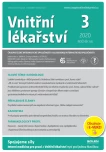Euvascor – early intervention of hypertension and dyslipidaemia (dual combination of atorvastatin and perindopril)
Authors:
Lukáš Zlatohlávek
Authors‘ workplace:
3. interní klinika 1. LF UK a VFN, Praha
Published in:
Vnitř Lék 2020; 66(3): 190-195
Category:
Overview
Over the last 30 years, the number of cardiovascular causes of death has decreased, but Cardi-ovascular Disease has been the leading cause of mortality and morbidity in the Czech Republic. In spite of a clear decline, this still persisting primacy is due to the failure to achieve the target recommended values and the late initiation of pharmacotherapy.
We know that lifetime LDL cholesterol exposure reduced by 1 mmol/l is associated with a 54% reduction in the incidence of coronary events. A lifetime lower systolic BP of 10 mmHg is associated with a 45% reduction in the incidence of coronary events. Lifetime exposure to a combination of LDL cholesterol lower by 1 mmol/l and systolic BP lower by 10 mm Hg was associated with a 78% reduction in the lifetime risk of coronary events and a 68% reduction in the lifetime risk of a cardiovascular death. The benefits of this intervention increase over time – long-term exposure to even a small difference in LDL cholesterol and systolic pressure can significantly reduce the lifetime risk of cardiovascular disease, if it persists over the time. In this respect, the recently presented new common ESC/ EAS recommendations from 2019, that is to focus treatment on dyslipidemia on a lifelong approach of reducing CV risk and therapeutic lifelong intervention with aim to achieve lower LDL cholesterol levels at all risk levels. Perindorpil antihypertezive and atorvasatin hypolipidemic drugs, ideally in a fixed combination, are able to reduce the patient's CV risk early. The ideal motivation for adherence of patients is the introduced concept of the vascular age, respectively the aging.
Keywords:
arterial hypertension – dyslipidemia – atherosclerosis risk factors – fixed combination therapy – early intervention – vascular age
Sources
1. Zlatohlávek L, et al. Klinická dietologie a výživa, CurrentMedia, Praha, 2016.
2. Mach F, Baigent C, Catapano AL, et al. 2019 ESC/EAS Guidelines for the management of dyslipidaemias: lipid modification to reduce cardiovascular risk, European Heart Journal (2019) 00, 1–78.
3. Lipitor (atorvastatin calcium) tablets. Parke -Davis, Moris Plains, USA, 1996 (Data on file). Malhotra HS, Goa K. Atorvastatin. An updated review of its pharmacological properties and use in dyslipidaemia. Drugs 2001; 61: 1835–1881.
4. Sever PS, Dahlöf B, Poulter NR, Wedel H, Beevers G, Caulfield M, Collins R, Kjeldsen SE, Kristinsson A, McInnes GT, Mehlsen J, Nieminen M, O‚Brien E, Ostergren J; ASCOT investigators. Prevention of coronary and stroke events with atorvastatin in hypertensive patients who have average or lower -than -average cholesterol concentrations, in the Anglo -Scandinavian Cardiac Outcomes Trial--Lipid Lowering Arm (ASCOT -LLA): a multicentre randomised controlled trial. Lancet. 2003 Apr 5; 361(9364): 1149–1158.
Labels
Diabetology Endocrinology Internal medicineArticle was published in
Internal Medicine

2020 Issue 3
Most read in this issue
- Local thrombolysis for deep vein thrombosis: why, for whom and how?
- What is hiden behind autoinflammation?
- Proteinuria from an internist‘s point of view
- Hepatorenal syndrome – update 2020
